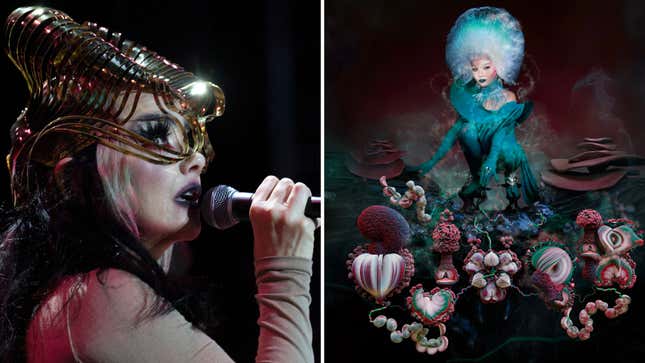‘Fossora’ Is Björk’s Most Intoxicating—and Inviting—Album in Years
The melodies are still tough, but the Icelandic singer-producer's "mushroom" project casts a trippy spell.
EntertainmentMusic

No matter how close Björk’s music comes to qualifying as pop—and for at least 10 years, she has strayed from the designation with seeming doggedness—she continues to go through the conceptual motions of a pop star. Each album represents its own formal era, with visual and musical aesthetics that remain consistent throughout the release and touring cycles. Björk’s commitment to a vibe is practically unsurpassed…until she completely changes course.
As her wonderful podcast Sonic Symbolism examines, each album is an answer to, and often a refutation of, what came before it. 1993’s Debut was largely produced alongside Nellee Hooper, so 1995’s Post was a “promiscuous” affair, stuffed with collaborators. Post was a cosmopolitan and extroverted portrait of time spent in London, so 1997’s Homogenic was recorded in virtual isolation in Spain. Homogenic was a sparse assault of strings and distorted, “volcanic” beats, so 2001’s Vespertine was warmed with the kind of laptop IDM that folded sometimes upwards of a hundred tracks into a single song, often with a pinprick approach to percussion. And on and on. It’s a kind of whisper-down-the-lane approach to convention breaking that keeps Björk truly avant garde and imbues each album with urgency—every time, this is what Björk has to say now.
One convention that she is seemingly unwilling to deviate from, though, is the reduced sense of melody in what she sings. It’s not that she’s atonal, per se—her music has remained plenty musical—but since 2011’s Biophilia, she’s been drifting away from the very concept of a hook. The putative center of her work has gotten harder, less user-friendly. Her recent music is less hummable than her earlier work. It seems to exist to be admired like a couture gown in a museum exhibition, and not loved, like a comfortable sweater in one’s personal wardrobe. As someone who has long understood Björk’s capacity for melody, I have found this turn alienating. She drops you off in these uncharted musical landscapes and goes about her business, absently humming a few notes over and over again to herself as she prunes the local flora.
-

-

-

-

-

-

-

-

-

-

-

-

-

-

-

-

-

-

-

-

-

-

-

-

-

-

-

-

-

-

-

-

-

-

-

-

-

-

-

-








































